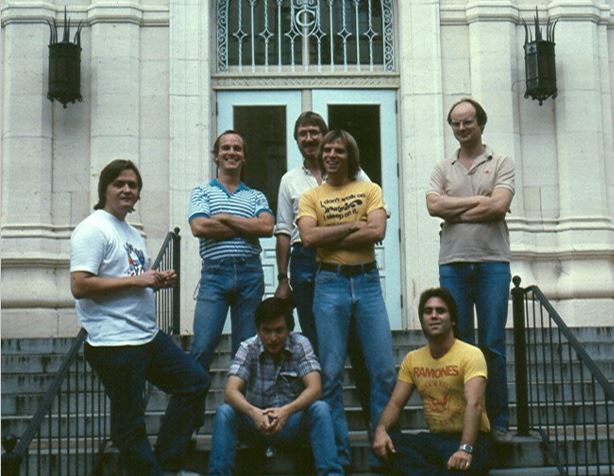At the end of the Spring 2020 semester, Professor Richard Atherley Jones formally retired from his position as Professor in the Department of Chemistry, marking the completion of a venerated 40 years of commitment to teaching and research. To mark this important milestone in Rich’s life, and to pay due tribute to his momentous impact on his students and the scientific community over four decades, we look back at some of the highlights of what has been a highly distinguished, memorable and fun-filled career.

In 1973, Rich gained admission as an undergraduate to study chemistry at the world-renowned Imperial College, London. Incidentally, in that same year, one of Imperial’s most famous scientists, Sir Geoffrey Wilkinson, was jointly awarded the Nobel Prize in Chemistry with E.O. Fischer for his pioneering work to prepare and characterize the first examples of metal-carbon bonds in organometallic compounds. Rich was taking the British equivalent of Freshman chemistry from Professor Wilkinson in the Fall of 1973 when the Nobel Prize in Chemistry was announced. In the following three years, and by the time Rich graduated with his B.S. degree, he had sufficiently impressed Geoffrey Wilkinson to be offered a place in his lab to study for a Ph.D. The latter degree took only two years to earn, and, as a spry 24-year-old, Dr. Richard A. Jones emerged as one of the rising stars of the booming organometallic community. Rich remained in Wilkinson’s lab for a further two years as a junior lecturer and post-doctoral scholar. Between 1976−1980, Rich led the development of the first well-defined coordination compounds containing metal-bridged methylene (−CH2−) groups, and developed the chemistry of hexamethyltungsten(VI) (WMe6). Several of Rich’s first research publications in 1977 also featured one Richard A. Andersen (subsequently of U.C. Berkeley until his passing, last year), who helped to train Rich in the art of air-sensitive chemistry and was instrumental in igniting his passion for chemistry.
By the time Rich left Imperial College, he had the ability to make practically any molecule he could imagine on paper. Armed with this prodigious talent, Rich took a rather unusual next career step for an Englishman at the time, and dipped his toes into the U.S. job market. And so, it was that in the fall of 1980, he arrived at the University of Texas at Austin to begin his independent career as an Assistant Professor. Rich and his fledgling group first worked on the preparation of coordination compounds using reactive phosphido (R2P−) ligands, which provided access to new types of catalytic reactivity and novel multi metallic structures. On the back of no fewer than 60 publications, Rich was duly promoted to the rank of Associate Professor with tenure in 1986. His early research accomplishments were recognized by the award of the Meldola Medal and Prize (given to the best British chemist under the age of 30), and for teaching he was the recipient of the College of Natural Sciences Teaching Excellence Award, both in 1983.
In-keeping with Rich’s drive, he was promoted again to Full Professor only two years later, in 1988. During this time, as part of his service to the community, Rich and his research group ran what became known as the “Chemistry Circus.” This consisted of a narrated hour long extravaganza of explosions, fire and novel chemical demonstrations, put on for High School students and their teachers, or anyone else who might be interested. The fire alarm was set off on a regular basis, although very little permanent damage occurred. It was around this time that Rich began to develop a collaborative relationship, as well as a steadfast friendship with Professor Alan H. Cowley. In fact, Rich and Alan’s friendship outside of the lab (and outside of the squash court; Alan Cowley was one of the few people who cou
Over the next three decades in Austin, Rich Jones and his group continued to produce innovative organometallic chemistry, while also moving into other new and topical areas of chemistry. Notably, the Jones group provided significant advances in the area of chemical vapor desorption (CVD), by preparing labile single-source precursors of Al, Ga and In, which enabled the clean synthesis of semiconductor thin films. In more recent times, the Jones group also became interested in the chemistry of the lanthanide elements, by preparing lanthanide-based complexes and materials with novel light emission and magnetic properties.
The overall body of work produced by Rich and his group is impressive both in its breadth and in the depth of detail, exemplified in each publication. Throughout his accomplished research career, Rich Jones has become known by his former graduate students as a kind and thoughtful mentor who is unerringly generous with his time support for their development as young scientists. In addition, Rich has upheld the highest standards as an educator of thousands of undergraduate students over his four decades in Austin, who have reveled in Rich’s smooth British lecturing style, which has always been underpinned by a deep understanding of inorganic chemistry.
As Rich now enters his well-earned retirement and becomes an Emeritus member of our faculty, we hope that we will still see him on campus from time-to-time. Rich and his wife, Sarah, have recently moved out of Austin to a new property near Marble falls, where Rich will be able to enjoy the countryside and the freedom to work on his ranch. Rich and Sarah’s two children, Paul (33) and Claire (30), are both proud graduates of U.T. Austin. In closing, the chemistry department wish Rich and his family all the very best in this next exciting phase, and we express a deep gratitude to Rich for helping to elevate our reputation through his always exemplary teaching and research.
Simon M. Humphrey
Austin, September 09, 2020.









